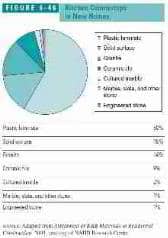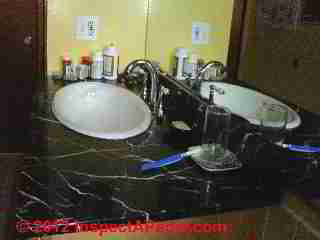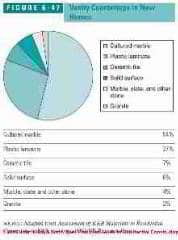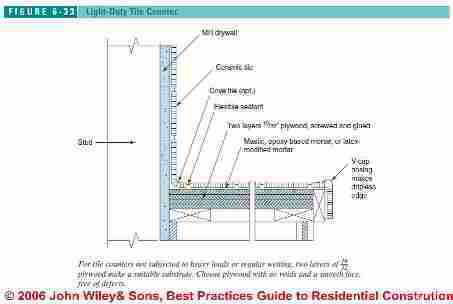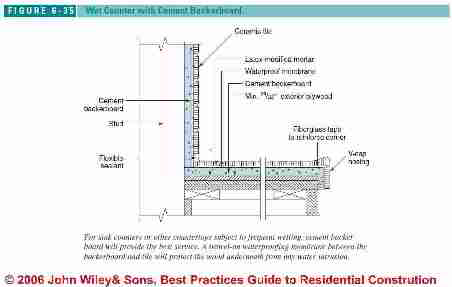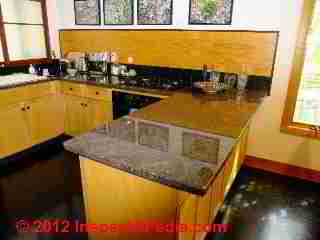 Design Guide & Choices of Countertops for Kitchens and Baths
Design Guide & Choices of Countertops for Kitchens and Baths
Also: countertop cleaners and sealants
- POST a QUESTION or COMMENT about kitchen & bath countertops: choices, materials, properties, installation, maintenance, repair
Countertop choices for kitchens or baths:
This article discusses the choices of kitchen countertops or bath countertop materials, including laminate countertops, cultured marble or engineered stone countertops, solid surfacing Corian type countertops, ceramic tile counters, and natural stone countertop choices among granite, marble, soapstone, slate.
We discuss the properties, pros and cons of each countertop type and material.
InspectAPedia tolerates no conflicts of interest. We have no relationship with advertisers, products, or services discussed at this website.
- Daniel Friedman, Publisher/Editor/Author - See WHO ARE WE?
Design Guide & Choices for Countertops for Kitchens and Baths
 As detailed in Chapter 6 of Best Practices Guide to Residential Construction (Steve Bliss, J Wiley & Sons) :
As detailed in Chapter 6 of Best Practices Guide to Residential Construction (Steve Bliss, J Wiley & Sons) :
After the cabinets, the countertop is the most visible element in most kitchen and bath designs.
[Click to enlarge any image]
In addition to providing a visual focal point, durable and easy-to-clean counters are critical for both hygiene and efficiency.
These workhorse surfaces should resist scratching, knife cuts, and burns, be impervious to water and stains, and wipe clean with a sweep of the sponge.
Figure 6-46 below offers a table of popularity of various countertop surfaces.
[Click any image or table to see an enlarged version with additional detail, commentary & source citation.]
Below we illustrate a cultured marble bath countertop installed in a bathroom where, as you can see from the table at left, use of this material is more common than in kitchens..
Nonporous surfaces like plastic laminate, solid surface, and engineered stone fit the bill well.
While plastic laminate still dominates the market based on its combination of good performance and low cost, both natural and manmade stone products now account for a substantial and growing share of the market (Figure 6-46 above and Figure 6-47 at above/left).
Since no one product can meet every need in a home, it often makes sense to mix and match materials, particularly in the kitchen.
The main counter areas might be plastic laminate or solid surfacing with special sections using, for example, stone for baking, wood for a cutting board, and tile for a place to set hot pots.
The most common countertop materials and their characteristics are shown in Table 6-8 below. [Click to enlarge any image]
[Click any image or table to see an enlarged version with additional detail, commentary & source citation.]
Countertop Design Issues
 For ease of use and maintenance, a
countertop will function best if it has the following
characteristics:
For ease of use and maintenance, a
countertop will function best if it has the following
characteristics:
- A smooth surface that is nonporous, stain-resistant, and has minimal joints and seams. At left we illustrate a ceramic tile countertop. It may have seemed a good idea to Larry and Toby, the builders who installed this surface, but it was a bear to keep clean.
- A flush or under mount sink that lets the homeowner easily sweep water and dirt into the sink.
- Backspashes should protect the wall above the countertop in a kitchen and often in a bathroom as well.
- Side splashes should go wherever a counter end meets a wall or tall cabinet. You can see this detail above below and to the right of those wall-mounted cabinets.
- A waterproof joint should be used where the counter meets the backsplash and side splashes. This means using a flexible sealant, not simply tile grout at any right-angled tile joints.
- A coved corner at the backsplash makes this joint easier to keep clean.
- In the kitchen: a no-burn area to set down hot pots.
- In the bathroom: a raised dripless counter edge helps keep water contained near the sink.
Also see CERAMIC TILE BACKSPLASH INSTALLATION
Cleanup Advice for Countertops
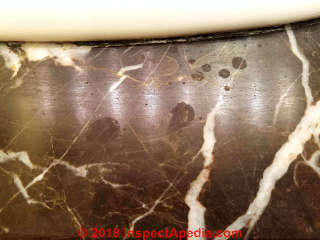 DF Comments: Here is a photo of water stains on the faux-marble bath or "cultured marble" countertop (actually a cast polymer) where I tried the countertop cleanup products discussed below - without much success on this surface.
DF Comments: Here is a photo of water stains on the faux-marble bath or "cultured marble" countertop (actually a cast polymer) where I tried the countertop cleanup products discussed below - without much success on this surface.
This countertop has been in use for about 15 years. There is a myriad of countertop cleaning and sealing products available as well as some common household cleaners that work perfectly well.
For example I've also found that glass cleaner works very well for removing grease and soap from marble, granite, stone, and faux-marble countertops.
The countertop spray sealer from SCI shown below is described as suitable for granite, limestone, concrete, marble, terrazzo, ceramic tile, slate, porcelain, brick, terra cotta, grout, and stucco surfaces.
The product contents are listed as water, EGBE Cas No. 111-76-2, isopropanol, and trade secret non-hazardous ingredients.
In applying this sealant to the same surface I described above I found it leaving a slight haze (that can be polished out) and an improvement in water resistance, but its use over about a decade has not diminished water staining on the cleaned and treated surface.
Photo below: Stone Care International (SCI) CleanEnCounters® spray countertop cleaner and spray countertop sealer.
In that photo the cleaner and sealer are posed on a granite countertop in the kitchen of the same home as the cultured marble bathroom countertop shown above.
After over nearly two decades of use the granite countertop remains un-marred.
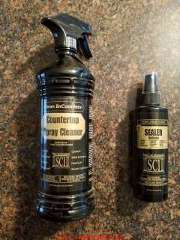 The countertop spray cleaner from SCI shown here is described as suitable for Corian®, Formica®, Granite, Silestone®, Solid surfaces, marble, quartz, and Wilsonart® countertop surfaces.
The countertop spray cleaner from SCI shown here is described as suitable for Corian®, Formica®, Granite, Silestone®, Solid surfaces, marble, quartz, and Wilsonart® countertop surfaces.
The sole active ingredient in the cleaner is described as nonionic surfactants, the remainder is water. I [DJF] have tried this cleaner on a faux-marble bath countertop.
While the cleaner does a fine job removing soap or surface grease, it will not remove nor diminish water stains or other stains in that surface.
Steve Bliss continues:
For most customers, easy cleanup of countertops is a top priority. While most of the materials discussed below are at least moderately stain-resistant, the actual performance will vary, depending on the specific color, pattern, finish texture (gloss vs. matte), and porosity of the material.
If possible, obtain samples of the materials being considered, with sealers applied if planned.
Mark each sample with a few stubborn stains: indelible marker, grape juice, salad oil.
Let them dry for an hour and then see how easily they clean up with normal household cleansers and nonabrasive cleaning pads.
Advice About High-Pressure (Plastic) Laminate Countertops
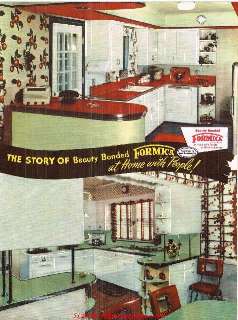 Plastic laminate still dominates the market for kitchen
counters, because it provides an attractive, durable surface
at a cost of $5 to $10 per square foot versus $50 to
$100 per square foot for solid surfacing or stone. The range
of colors and textures continues to expand with new printing
technologies that have produced realistic looking wood
and stone surfaces.
Plastic laminate still dominates the market for kitchen
counters, because it provides an attractive, durable surface
at a cost of $5 to $10 per square foot versus $50 to
$100 per square foot for solid surfacing or stone. The range
of colors and textures continues to expand with new printing
technologies that have produced realistic looking wood
and stone surfaces.
Made from a sandwich of resin-impregnated kraft paper, a decorative paper layer, and a top layer of clear melamine fused under heat and pressure, plastic laminate is impervious to moisture and resists scratches, dents, and chips. It can be scratched with a knife, however, or scorched with a hot pot. Small chips can be repaired with special sealers, but scratches and burns are permanent.
Before selecting a countertop color, it is a good idea to test a few sample squares with an indelible marker to see how easily the marks clean off. Matte finishes stain much more readily than gloss, and there may be considerable variation from one pattern and finish to another.
More expensive color through plastic laminates show wear less than the standard type, and they eliminate the dark band at exposed edges.
If using a postformed counter with a miter joint, it is essential to mechanically draw the joint tight and to seal that joint to prevent water intrusion, which will degrade the particleboard and open the joint. Silicone or special laminate seam sealer can be used.
Illustration: Formica countertops from 1950 excerpted from FORMICA COUNTERTOPS CATALOG 1950 [PDF] [Click to enlarge any image]
Edge Treatment Choices for Countertops
There are now many alternatives to the traditional square edge that exposes the dark edge of the horizontal sheet of laminate. The least expensive is a postformed counter with either a seamless square edge or raised dripless edge.
A wide variety of upgrades are available to dress up the counter. Beveled laminate, solid surfacing, and hardwood edging are common details.
Site applied wood edging, however, can lead to problems over time if the joint is not watertight.
Cast Polymer (Cultured Marble, Engineered Stone) Countertop Guide
Cultured marble, solid surfacing, engineered stone, and most other composites used in kitchen and bath counters, sinks, and wall panels are different types of cast polymer. Cast polymer products consist of a plastic resin, either acrylic or polyester, and a mineral filler.
The type and amount of filler largely determines the hardness, stain resistance, and overall durability of the product. Cultured marble, for example, which uses crushed limestone as a filler, is relatively soft and porous and needs to be protected by a gel coat.
The new granite and quartz “engineered stone” composites, on the other hand, are nearly indestructible. These materials are described in greater detail below.
Guide to Cultured Marble Countertop Properties & Quality
Cultured marble has been produced since the 1960s. It combines ground-up marble dust with polyester resins and pigments to make a sheet material for use in kitchens and bathrooms, as well as fireplace surrounds and other ornamental applications.
Nearly all cultured marble products are finished with a thin clear or colored gel coat, which provides the color and pattern and creates a relatively hard and stain-resistant skin.
Quality varies widely, as there are hundreds of small-volume manufacturers around the country producing the material. Some of the lower-quality products have had problems with crazing (small cracks) in the gel coat around drains and other areas subjected to thermal shocks. High-quality products should carry a label certifying compliance with ANSI standard Z-124.
While cultured marble is stronger and less brittle than natural marble, it is less impact-resistant and scratch resistant than other cast polymers such as solid surfacing. The nonporous surface resists mildew and most stains and is easily cleaned with nonabrasive cleaning agents.
Cultured marble is commonly used for vanity tops with integral sinks, as well as shower and tub enclosures, but it is rarely used for kitchen counters. Scratches and small chips can be repaired using a special gel-coat compound available from the supplier, but cracks or breaks cannot be repaired. Since the gel coat provides the color and pattern, significant damage to the gel-coat cannot be repaired.
The sheen, however, can be restored with a thin coat of auto wax or Gel Gloss (TR Industries).
Because many of the light-colored products are translucent, they should always be installed on a light-colored background material with clear silicone adhesive.
Solid Surfacing Corian-type Countertop Guide
Initially introduced as Corrigan® by Dupont almost 40 years ago, solid surfacing products consist of mineral fillers, usually alumina trihydrate (a product of bauxite), and acrylic or polyester resins. Solid surfacing is a hard and durable homogenous material with color throughout and is easily machinable with woodworking tools.
It can be seamlessly welded to itself at joints and to under mount sinks made of the same material. This creates an attractive, continuous work surface that is easy to wipe clean. An economical veneer version, laminated over a particleboard substrate, is available from some manufacturers.
Because solid surfacing is nonporous, stains do not penetrate and it will not support mold or bacterial growth. Most stains can be wiped away with a nonabrasive pad and mild cleanser, although bleach is OK if needed. It also resists mild chemicals, but it should not be exposed for long to harsh chemicals, such as acetone or paint thinner. The alumina trihydrate filler also makes solid surfacing fire resistant, although it is possible to scorch the surface.
While relatively easy to scratch or stain, solid surfacing is easily repaired. Tough stains as well as minor scratches or burns can be buffed out of a matte finish with an abrasive cleanser and Scotch-Brite pad, or wet sanded with very fine sandpaper (start with 1000-grit and use coarser grits as needed). Most solid surfacing used on countertops has a matte-satin finish, which is the easiest to maintain. For a gloss finish, follow the recommendations of the manufacturer.
Recommendations for Using Engineered Stone Countertops
The newest class of cast polymer, sometimes called composite or engineered stone, uses a high percentage of quartz, quartz silica, and granite to produce a material with the hardness of natural stone and the easy maintenance of solid surfacing. Engineered stone typically has over 90% stone aggregate with just enough acrylic resin and binders to hold it together. Combined under heat and pressure, the resulting material is uniform throughout and has greater flexural strength than stone.
The nonporous surface is virtually stain-proof and very scratch-resistant, although it should not be used as a cutting board. Unlike natural stone, it does not require any sealing or waxing. Although it will not burn or scorch, placing hot pots directly on the surface can cause surface damage from the thermal shock.
Some manufacturers are able to add a seamless under mount solid-surface sink to the engineered stone slab, adding to the appeal of the material. Products include Silestone® (Cosentino USA), Zodiaq®, (Dupont), Cambria®, (Cambria), Technistone® (Technistone USA), Ceasarstone® (U.S. Quartz Products), and Granyte® (Halstead International).
Guide to Choosing Ceramic Tile Countertops
Ceramic tile is a popular countertop material in the West and Southwest. Its main advantages are high durability and imperviousness to heat and water. Glazed tiles will not stain, and tiles rated for use on floors and counters are very scratch resistant.
Softer tiles are prone to chipping, but damaged tiles can be removed and replaced if necessary.
Installing ceramic tile on one section of counter near the range can provide a handy place to set down hot pots and pans.
The main problem with tile counters are the grout joints, which tend to discolor over time. Using a latex modified grout and sealing the grout will help but will not prevent stains altogether. The best solution is to use an epoxy grout and to choose a dark or neutral grout color such as gray.
Lighter colors are generally OK on backsplashes and walls.
Tile is also very hard and prone to breaking fragile glasses or dishes that strike it.
[Click any image or table to see an enlarged version with additional detail, commentary & source citation.]
Two details that will enhance a tile counter are a V-cap nosing tile, which will create a clean-looking dripless edge, and a coved corner at the backsplash, which will make it easier to keep the corner clean. Tile counter details are shown in Figure 6-33 above and Figure 6-35 below.
Figure 6-35
See details at
Guide to Choosing Natural Stone Countertops
Natural stone has become as popular as solid surfacing in the past few years as stone prices have dropped and finished stone slabs have become more widely available.
In general, natural stone is hard, heavy, and cold, and is unaffected by heat and water. Bakers like the cool, smooth surface for handling dough. Stain and scratch resistance varies with stone type, but all stones need some type of sealer to prevent staining. The most common choices are discussed below:
- Granite countertop properties: Very hard and resistant to scratching or chipping. Takes high polish. Oil and grease may stain granite if not sealed.
- Marble countertop properties: Acidic foods etch or dull surface. Porous
surface absorbs oils, stains, and some odors if not
sealed. Avoid abrasive pads or cleansers.
See MARBLE CLEANING METHODS - Soapstone countertop properties: Very dense and stain-resistant but relatively soft. Usually treated with mineral oil. Scratches can be sanded out.
- Slate countertop properties: Very stain-resistant. May need sealers depending on quality of stone. Minor scratches can be buffed out with steel wool.
Plastic Laminate Countertop Manufacturers List
Abet Inc. www.abetlaminati.com
Arborite www.arborite.com
Formica Corp. www.formica.com
Nevamar Decorative Surfaces www.nevamar.com
Pionite Decorative Surfaces www.pionite.com
Wilsonart International www.wilsonart.com
Solid Surface Countertop Manufacturers
Avonite Surfaces www.avonite.com
Centura Solid Surfacing www.centurasolidsurface.com
Dupont www.corian.com
Formica Corp. www.formica.com Formica solid surfacing, formerly Surell and Fountainhead
Halstead International www.e-topstone.com Topstone solid surface distributor
Lippert Corp. www.lippertcorp.com
Sansung Staron www.getstaron.com Swanstone www.theswancorp.com
TFI www.tficorp.com
Transolid Inc. www.transolid.com
Wilsonart International www.wilsonart.com
Engineered Stone Countertop Manufacturers
Cambria www.cambriausa.com Cosantino USA www.silestoneusa.com
Dupont www.zodiaq.com
Halstead International www.halsteadintl.com Granyte distributor
Technistone USA www.technistoneusa.com
U.S. Quartz Products www.caesarstoneus.com
-- Adapted with permission from Best Practices Guide to Residential Construction (Steve Bliss, J Wiley & Sons) .
This article describes common defects found at installed cabinets and countertops. This article series discusses current best design practices for kitchens and bathrooms, including layout, clearances, work space, and accessible kitchen and bathroom layout, clearances, turning space, grab bars, controls, etc. We include advice on choosing and installing kitchen countertops, cabinets, and kitchen or bathroom flooring, sinks, and other plumbing fixtures and fixture controls such as faucets.
...
Continue reading at CERAMIC TILE BACKSPLASH INSTALLATION, or select a topic from the closely-related articles below, or see the complete ARTICLE INDEX.
Or see these
Recommended Articles
- BATH & KITCHEN DESIGN GUIDE - home
- CABINETS & COUNTERTOPS - topic home,
- CABINET DESIGN GUIDE, KITCHEN
- CERAMIC TILE BACKSPLASH INSTALLATION
- CERAMIC WALL TILE INSTALLATION
- FORMICA COUNTERTOPS CATALOG 1950 [PDF]
Suggested citation for this web page
COUNTERTOPS, KITCHEN & BATH at InspectApedia.com - online encyclopedia of building & environmental inspection, testing, diagnosis, repair, & problem prevention advice.
Or see this
INDEX to RELATED ARTICLES: ARTICLE INDEX to BATH & KITCHEN
Or use the SEARCH BOX found below to Ask a Question or Search InspectApedia
Ask a Question or Search InspectApedia
Questions & answers or comments about kitchen & bath countertops: choices, materials, properties, installation, maintenance, repair.
Try the search box just below, or if you prefer, post a question or comment in the Comments box below and we will respond promptly.
Search the InspectApedia website
Note: appearance of your Comment below may be delayed: if your comment contains an image, photograph, web link, or text that looks to the software as if it might be a web link, your posting will appear after it has been approved by a moderator. Apologies for the delay.
Only one image can be added per comment but you can post as many comments, and therefore images, as you like.
You will not receive a notification when a response to your question has been posted.
Please bookmark this page to make it easy for you to check back for our response.
IF above you see "Comment Form is loading comments..." then COMMENT BOX - countable.ca / bawkbox.com IS NOT WORKING.
In any case you are welcome to send an email directly to us at InspectApedia.com at editor@inspectApedia.com
We'll reply to you directly. Please help us help you by noting, in your email, the URL of the InspectApedia page where you wanted to comment.
Citations & References
In addition to any citations in the article above, a full list is available on request.
- Best Practices Guide to Residential Construction, by Steven Bliss. John Wiley & Sons, 2006. ISBN-10: 0471648361, ISBN-13: 978-0471648369, Hardcover: 320 pages, available from Amazon.com and also Wiley.com. See our book review of this publication.
- Our recommended books about building & mechanical systems design, inspection, problem diagnosis, and repair, and about indoor environment and IAQ testing, diagnosis, and cleanup are at the InspectAPedia Bookstore. Also see our Book Reviews - InspectAPedia.
- Best Practices Guide to Residential Construction, by Steven Bliss. John Wiley & Sons, 2006. ISBN-10: 0471648361, ISBN-13: 978-0471648369, Hardcover: 320 pages, available from Amazon.com and also Wiley.com. See our book review of this publication.
- What Style Is It?: A Guide to American Architecture, Rev., John C. Poppeliers, S. Allen Chambers, Wiley; Rev Sub edition (October 6, 2003), ISBN-10: 0471250368, ISBN-13: 978-0471250364
- In addition to citations & references found in this article, see the research citations given at the end of the related articles found at our suggested
CONTINUE READING or RECOMMENDED ARTICLES.
- Carson, Dunlop & Associates Ltd., 120 Carlton Street Suite 407, Toronto ON M5A 4K2. Tel: (416) 964-9415 1-800-268-7070 Email: info@carsondunlop.com. Alan Carson is a past president of ASHI, the American Society of Home Inspectors.
Thanks to Alan Carson and Bob Dunlop, for permission for InspectAPedia to use text excerpts from The HOME REFERENCE BOOK - the Encyclopedia of Homes and to use illustrations from The ILLUSTRATED HOME .
Carson Dunlop Associates provides extensive home inspection education and report writing material. In gratitude we provide links to tsome Carson Dunlop Associates products and services.


